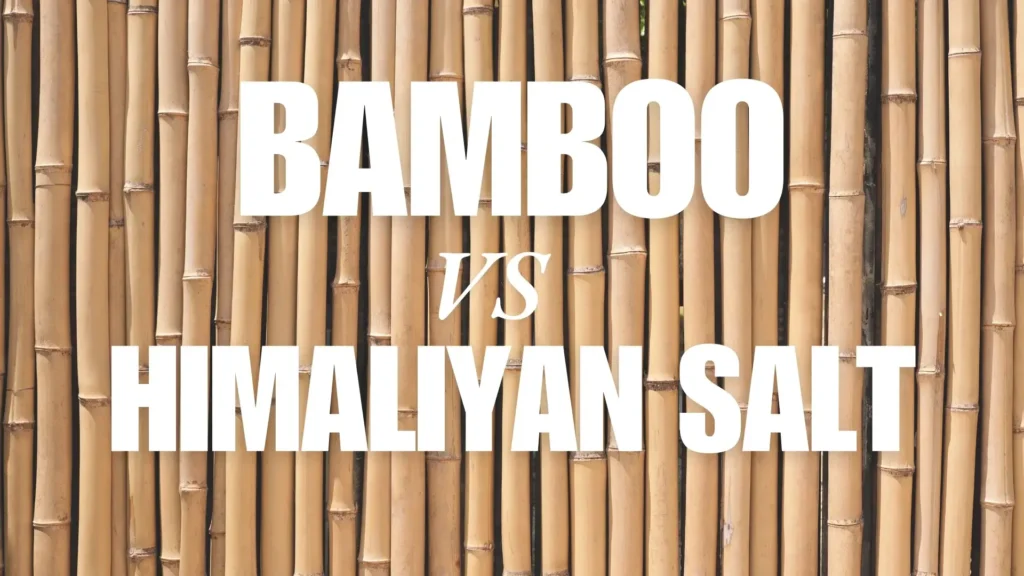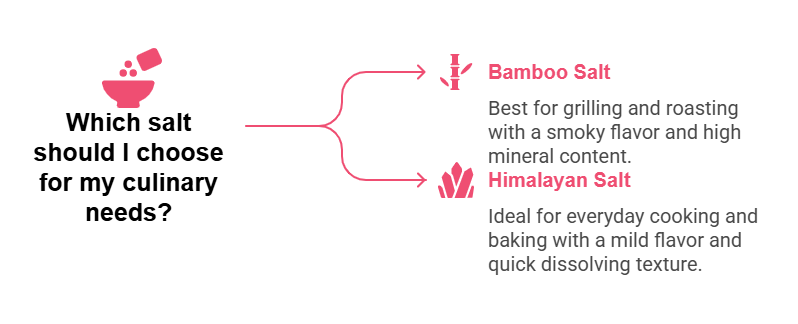
Table of Contents
Salt isn’t just something we sprinkle on food. It’s the magic that turns plain dishes into something delicious. From seasoning your fries to curing meats, salt is a kitchen essential. But in recent years, people have been exploring different types of salt for both taste and health benefits.
Two names that often pop up in foodie and health circles are Bamboo Salt vs Himalayan Salt. At first glance, they might look like just two types of salt with fancy names. But when you dig deeper, you’ll find that they’re quite different in how they’re made, how they taste, and how they can be used in your cooking.
If you’ve been wondering which one is better for your kitchen or even for your health this guide will break it all down for you in the simplest way possible.

What Is Bamboo Salt?
Bamboo Salt has an interesting story. It comes from Korea and has been used for centuries, not just for cooking but also in traditional medicine. The process of making it is long and careful: sea salt is packed into thick bamboo tubes, sealed with clay, and roasted over a pinewood fire.
This roasting isn’t done just once, it’s usually repeated several times (sometimes up to nine). Each roasting allows the salt to absorb minerals from the bamboo and the clay, giving it a very distinct character.
What makes Bamboo Salt special:
- Rich in minerals like calcium, iron, and magnesium.
- Has a unique smoky, earthy flavor.
- Slightly alkaline, which some believe helps balance the body’s pH.
Because of its flavor and mineral richness, Bamboo Salt is often considered a gourmet choice for people who like bold, deep tastes in their food.
What Is Himalayan Salt?
Himalayan Salt has its own charm and a completely different origin. It’s mined from ancient salt deposits found deep in the Himalayan mountains of Pakistan. These deposits are millions of years old, formed when ancient seas evaporated.
Unlike many processed salts, Himalayan Salt is minimally refined and free from additives. Its beautiful pink color comes from trace minerals, especially iron oxide (rust particles in their natural, harmless form).
Read more: The History of Himalayan Salt.
What makes Himalayan Salt special:
- Contains over 84 trace minerals and elements.
- Has a mild, clean taste.
- Naturally eye-catching pink crystals, available in both fine and coarse forms.
It’s widely loved for its versatility in the kitchen from everyday cooking to decorative salt blocks for serving food.
Taste Comparison: Bamboo Salt vs Himalayan Salt
Taste is where these two Bamboo Salt vs Himalayan Salt really stand apart.
Bamboo Salt Taste
If you’ve ever enjoyed the aroma of food cooked over a wood fire, you’ll appreciate Bamboo Salt’s flavor. It’s smoky, earthy, and slightly intense. The taste isn’t harsh; instead, it adds depth to whatever you’re cooking.
Best for:
- Grilled meats like steak or lamb.
- Roasted vegetables such as sweet potatoes or mushrooms.
- Stir-fried dishes that need a bold seasoning kick.
Think of Bamboo Salt as a seasoning that not only adds saltiness but also an extra layer of flavor like a natural smoky seasoning.
Himalayan Salt Taste
Himalayan Salt is the opposite in taste profile. It’s mild, clean, and slightly sweet. This makes it incredibly versatile and enhances the natural flavors of food without overpowering them.
Best for:
- Everyday cooking (soups, salads, pasta, rice dishes).
- Baking, where you don’t want strong flavors from your salt.
- Finishing delicate foods like seafood or fresh greens.
Because of its subtleness, Himalayan Salt is also a great choice when you want to control the saltiness of a dish more precisely.
Read More: How To Cook On Himalayan Salt Slabs
Texture and Appearance
Both salts have distinct textures and appearances, and this plays a role in how they’re used.
Bamboo Salt Texture
Bamboo Salt usually comes in coarse grains. These larger crystals dissolve slowly, so the saltiness and smoky flavor release gradually. That’s why it works great as a finishing salt sprinkled over food just before serving.
Its color can range from light grey to purple, depending on how many times it’s roasted. The color itself can make dishes look a bit more rustic and artisanal.
Himalayan Salt Texture
Himalayan Salt comes in fine and coarse versions. Fine salt dissolves quickly, making it perfect for soups, sauces, and marinades. Coarse salt works better as a finishing salt or for brining meats.
It’s famously pink from pale blush to deep rose which also makes it attractive for decorative serving, like on salt blocks or in grinders on the dining table.
Cooking Benefits
Bamboo Salt Cooking Benefits
- Adds depth and smokiness: Ideal for grilled and roasted foods.
- Slow-dissolving texture: Great for marinades and finishing touches.
- Unique color: Can make simple dishes look more gourmet.
- Mineral-rich: May provide extra nutrients compared to regular table salt.
Example use: Sprinkle Bamboo Salt over freshly roasted vegetables for a smoky, savory bite that doesn’t need any extra seasoning.
Himalayan Salt Cooking Benefits
- Versatile flavor: Works in both sweet and savory dishes.
- Fine or coarse options: Adapts to any recipe.
- Can be used for cooking blocks: Salt slabs can grill or serve food with mild seasoning.
- Mineral content: Provides trace minerals along with saltiness.
Example use: Use fine Himalayan Salt in bread dough to evenly distribute flavor without overpowering the other ingredients. You might also like to read How Use Himalayan Salt For Cooking.
Bamboo Salt vs Himalayan Salt at a Glance
Feature | Bamboo Salt | Himalayan Salt |
Origin | Korea, roasted in bamboo tubes | Pakistan, mined from Himalayan range |
Flavor | Smoky, earthy, bold | Mild, clean, slightly sweet |
Texture | Mostly coarse, slow dissolving | Fine or coarse, quick dissolving |
Best Uses | Grilling, roasting, finishing salt | Everyday cooking, baking, finishing |
Appearance | Grey to purple | Pink to deep rose |
Mineral Content | High, alkaline | Rich in trace minerals |
Read More: Black Salt vs Pink Salt: Key Differences, Benefits & Best Uses
Which One Should You Choose?
The answer really depends on your cooking style and taste preferences.
Choose Bamboo Salt if:
- You love smoky, bold flavors.
- You often grill, roast, or make stir-fries.
- You want something unique that stands out in both taste and appearance.
Choose Himalayan Salt if:
- You prefer a more neutral, versatile salt.
- You cook a wide variety of dishes daily.
- You like the visual appeal of pink crystals.
Many chefs and home cooks actually keep both in their kitchen Bamboo Salt for special recipes and Himalayan Salt for everyday use.
Read More: Understanding the Mineral Composition of Himalayan Pink Salt
Where to Get the Best Quality
Not all salts are equal in quality. Some are over-processed, losing their natural minerals and flavor. At Sobaan Salts, we carefully source and prepare both Bamboo Salt and Himalayan Salt to retain their purity and natural benefits. Whether you’re after the smoky richness of Bamboo Salt or the gentle versatility of Himalayan Salt, our products are made to bring the best out of your cooking.
Final Thoughts
Whether you choose the smoky boldness of Bamboo Salt or the mild versatility of Himalayan Salt, picking a trusted source like Sobaan Salts ensures you’re getting pure, mineral-rich salts that truly elevate your cooking.
Both Bamboo Salt vs Himalayan Salt can do more than just make your food salty, they can enhance flavors, add texture and even bring visual beauty to your dishes. Bamboo Salt offers a bold, smoky edge perfect for grilling and roasting, while Himalayan Salt delivers a gentle, clean taste that works in just about anything. Having both in your kitchen means you’re ready to season like a pro, no matter what you’re cooking.
The global gourmet salt market is valued at USD 1.6 billion in 2025, projected to reach USD 3.2 billion by 2035 at a CAGR of 7.2%, driven by demand for natural, mineral-rich products.
The bamboo salt market is estimated at USD 31.6 billion in 2024, expected to grow to USD 66.1 billion by 2031, fueled by interest in its unique health benefits.
(Source: Future Market Insights for gourmet salt and OpenPR for bamboo salt)
References
- Healthline – Pink Himalayan Salt: Is It Better Than Regular Salt?
- WebMD – Himalayan Salt: Is It Good for You?
- ScienceDirect – Mineral Composition, Crystallinity and Dielectric Evaluation of Bamboo Salt, Himalaya Salt, and Ba’kelalan Salt
You Can Also Check These Blogs:
Share This Post
Article By

